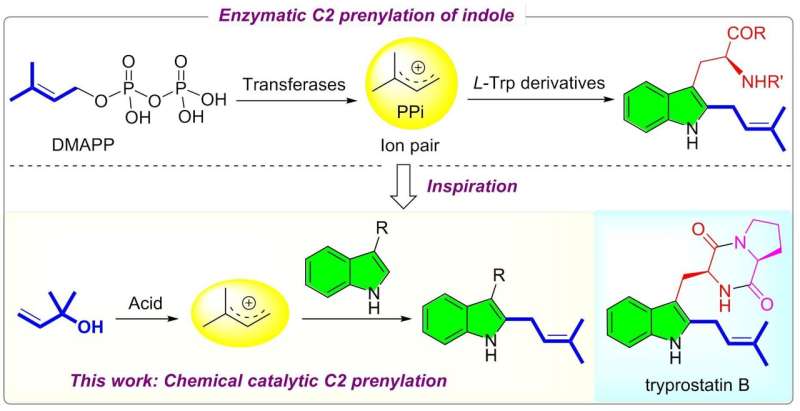Bioinspired acid-catalyzed C2 prenylation of indole derivatives

Biomimetic catalysis is an emerging concept that emulates key features of enzymatic process. Prenylation is a ubiquitous process found in almost all living organisms. Inspired by the enzymatic mechanism, researchers developed a selective C2 prenylation of indoles via chemical catalysis, which can be applied to late-stage diversification of tryptophan-based peptides and concise synthesis of tryprostatin B.
Terpenoids are omnipresent in almost all living organisms. Prenylated indoles are prominent representatives that usually display potent medicinal properties (e.g. tryprostatin B). Therefore, significant efforts have been devoted to indole prenylation over the past decades. The known protocols often require a multi-step procedure and rely on the use of stoichiometric promoters. From the viewpoint of step- and atom-economy, developing a direct catalytic C2 prenylation of indoles is highly desirable yet challenging, because the nucleophilicity of C2 site is weaker than that of other two positions (N, C3).
In biosynthesis, enzymatic indole prenylation proceeds through a Friedel-Crafts SN1-type alkylation with a prenyl cation-pyrophosphate ion (PPi) derived from dimethylallyl pyrophosphate (DMAPP). Inspired by this mechanism, recently, a team led by Prof. Qing-An CHEN from Dalian Institute of Chemical Physics (DICP) of the Chinese Academy of Sciences (CAS) developed a regioselective C2 prenylation of indoles enabled by Lewis acid catalysis. By employing cheap 2-methyl-3-buten-2-ol (tert-prenol) as precursor and Lewis acid AlCl3 as catalyst, various tryptophol and tryptamine derivatives can undergo C2 prenylation with high selectivity. Notably, this practical strategy can be applied to the late-stage diversification of tryptophan-based peptides. These results were published in Chinese Journal of Catalysis.
Prof. CHEN stated: "Our work represents an old reaction for new use. For anyone engaged in chemistry, it is difficult to imagine that tryptophol and tryptophan-based peptides can undergo Friedel-Crafts reaction with high selectivity, because of the presence of diverse free NH and OH. More importantly, this strategy can greatly shorten the synthesis of indole alkaloid tryprostatin B."
More information: Yan-Cheng Hu et al, Catalytic C2 prenylation of unprotected indoles: Late-stage diversification of peptides and two-step total synthesis of tryprostatin B, Chinese Journal of Catalysis (2021). DOI: 10.1016/S1872-2067(20)63780-9
Provided by Chinese Academy Sciences





















